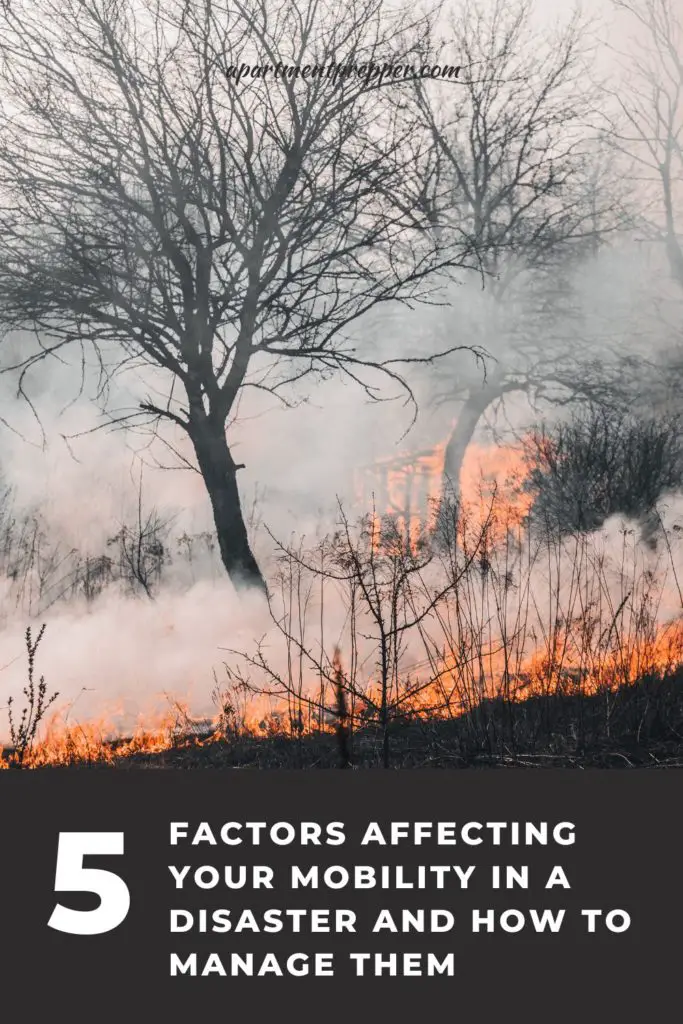Written by Martin A. Banks
One of your biggest choices in an SHTF scenario is whether to stay or go. While there are multiple advantages to bugging in, doing so isn’t always practical if flames devour your home or your immediate area descends into chaos, such as when natural disasters strike. What factors can affect your mobility when bugging out, and how can you address them?
Some matters lie firmly within your control, like carrying the right gear, while others, like impassable roadways, require quick thinking on your feet. What should you consider in advance?
Here are five factors affecting your mobility and how to manage them.
1. How Quickly You Act
The first 72 hours following a SHTF scenario are the most critical. People take varying amounts of time to emerge from their shocked states, but once they do, things quickly become more hazardous — and frustrating. Do you remember how quickly toilet paper flew off store shelves in February 2020?
Sometimes, mandatory evacuation orders give you no choice but to bug out and little time to grab your things and go. Otherwise, you must consider the following factors affecting your mobility:
● Road closures: Government officials could cut off escape routes to quarantine disease, for example.
● Traffic jams: Many preppers boast about taking to the backwoods during SHTF. Few consider how they will get there once traffic turns every 2-lane country road, let alone freeway, into a parking lot.
It helps to run through potential scenarios with your loved ones and decide in advance what compels you to flee. The above realities leave you little time to waffle.
Communication in an SHTF Scenario
One factor that can prevent you from hitting the road is waiting on your family members. Ensure everyone you’re bugging out with has a cellphone and backup charger, and practice a chain of command for notifications to get everyone to the rendezvous point quickly.
2. Your Getaway Vehicle
The right getaway vehicle can make your escape significantly easier and more comfortable. RVs appeal to many, especially those with large families. However, they’re tough to maneuver on crowded roadways, and some models lack sufficient ground clearance for tackling any dirt road tougher than those in your standard KOA. Weigh the vehicle’s carrying capacity against the realities you may face in a SHTF scenario.
You might have all you need in a utility trailer. One advantage is you can haul it with a standard car instead of a bulky truck. Such models save money on gas while providing a place to pitch your tent off the cold ground. Aluminum models are also lighter than most other trailer types, making them a smart choice.
3. Your Home Base
Remember the scene in Stephen King’s “The Stand,” where two characters must traverse a pitch-black Lincoln Tunnel full of decaying corpses? Your home base is a significant factor in your mobility. It’s significantly tougher to bug out from downtown Manhattan than your typical suburban rancher.
Memorize this one basic rule: the more urban your location, the more urgent it is to leave immediately. City centers are likely targets during war and civil unrest and exits close quickly.
Furthermore, you must dress for your location’s topography, as you may well end up on foot. Ensure your bug-out bag contains plenty of clean underwear and socks to prevent bacterial contamination, and wear layers, dressing appropriately for your climate. Above all, protect your feet with comfortable walking shoes — leave the strappy heels at home, please.
4. Your Supply Stash
You need more than clean skivvies in your bug-out bag. Assuming the air is safe to breathe, your next necessity of life is water — but it’s heavy as heck to carry. Ensure everyone in your circle has more than one purification method and knows how to use it. Run drills.
What else belongs in your bug-out bag? Here’s a short list:
● Communications: Cellphone, backup chargers and a GPS communications system is ideal.
● First aid: Bandages and wraps, antiseptic ointments and wipes, splints, scissors, tweezers, OTC and prescription medications, mouth and hand barriers.
● Hygiene: Camp-safe soap, hand sanitizer, wipes if in a place with little water.
● Tools: A fire-starting kit with waterproof matches, multiple lighters and a flint and steel, a magnetic compass in case of electronic device loss, poles for shelter, fishing and trekking, a knife, a hatchet, a mallet and multi-tool.
● Self-defense: Firearms only if trained and comfortable in their use. Otherwise, pepper spray, bear spray or a taser. A trekking pole or knife can also serve in a pinch.
● Nourishment: Water purification methods, light, healthy snacks like trail mix.
5. Your Fitness and Know-How
Your biggest tool in a SHTF scenario is yourself. How fit are you mentally and physically? Are you up to the challenge, and if not, what can you do to get yourself there?
Even if you have a disability, getting as fit as possible significantly increases your survival chances. Two people could have the same heart defect, but the one who climbs on the treadmill a few times a week will lap their couch-potato counterpart. Remember, the first rule of Zombieland is cardio —but you don’t have to be the fastest, as long as you aren’t the slowest.
Furthermore, take every opportunity to practice survival skills. It’s one thing to know how to use a flint and steel in theory, but quite another when it’s pouring rain and the only thing standing between you and frostbite is the fire you can’t start.
Factors Affecting Mobility and How to Manage Them
Whether to bug out is one of the biggest choices you face in a SHTF scenario. Examining the factors affecting your mobility and managing them before disaster strikes increases your survival chances when you must hit the road.
Think carefully about the above, and craft your exit strategy today.
About the author
Martin Banks is the managing editor at Modded. Follow him on Twitter @TModded for frequent updates on his work.
Today’s societal climate not supportive of prepping. With your help, we can keep bringing you content that is often suppressed. Help keep Apartment Prepper alive.
Join me on Patreon for ad-free content.
Or Help out via Paypal





